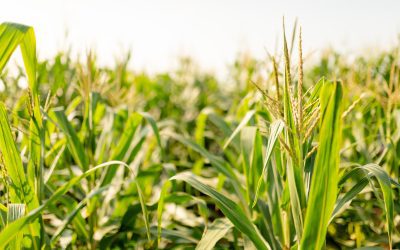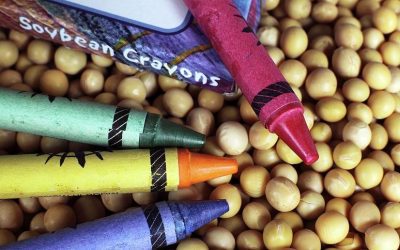Global trade concerns and the 2023 Farm Bill were the highlights from the Ag Policy Summit on July 21 at the CRG Events Center in Plainfield, Ind. The Summit is an annual policy-focused program presented by the Indiana Corn Growers Association (ICGA) and the Indiana Soybean Alliance’s Membership and Policy Committee (M&P).
“We hold this event every summer, so that farmers and industry professionals can come together to discuss the pressing issues of the ag sector,” said ICGA President Scott Smith, a farmer from Windfall, Ind. “I want to first offer my thanks to our Premier Sponsor, Corteva Agriscience. I also want to thank our supporting sponsors: Bose Public Affairs Group, the United Soybean Board, the Indiana Soybean Alliance (ISA), and the Indiana Corn Marketing Council (ICMC). We could not put on these events without our sponsors and our farmer members.”
Trade isn’t only an issue for M&P and ICGA. Indiana’s corn and soybean checkoff organization’s work to expand global export opportunities for Hoosier row crop producers. ISA Board Chair Jim Douglas, a farmer from Flat Rock, Ind., said the soybean checkoff is pleased to sponsor the Ag Policy Summit and listen to experts discuss the future of America’s farm export policy.

“It has been found that $12 comes back to the farm for every dollar invested into the checkoff programs – including our program priorities of Sustainability, New Uses, Value Creation, Producer Engagement and Market Development,” Douglas said. “ISA, along with the Indiana Corn Marketing Council, have continued to build relationships with foreign trade partners so our soybean and corn export markets stay strong. These countries include Colombia, Panama, South Korea and Vietnam to name a few.”
Mexico’s regulation on glyphosate
Challenging political issues are nothing new for Kevin Diehl, Director of Global Regulatory Affairs with Corteva Agriscience. Diehl kicked off the Summit’s agenda with a talk about biotech global trade issues. He warned farmers that they might lose a good trading partner due to restrictions on glyphosate.

“There was a decree that was put in place in Mexico with their administration back in 2018, which was focused on glyphosate and traits that enabled glyphosate use on major crops, and then their regulatory system really shut down for 2-3 years,” Diehl explained. “It’s now back up and running, but there is a focus with that decree on moving away from crops by 2024 that contain glyphosate traits or have had that product used on it. To understand how big of a trading partner Mexico is for U.S. farmers, about 5 percent of the U.S. corn crop goes to Mexico. They’re a very important trade partner, and they have been for a long time. We’ve had good relationships with them. This is something, as we look to (2024) on the horizon, it’s something that we’re going to need to address and solve. If you look at their need for U.S. grain, and our need to have good trading partners, this is important to solve.”
He believes the federal government will try to resolve the issue with Mexico, but he believes it will also require industry support.
“It’s all about advocacy and having conversations,” Diehl said. “There are mechanisms in place where the government is working back and forth, and some of those discussions are starting to happen. It’s important for the U.S. government to continue to be engaged, and I think they will be. But, looking at 2024, it’s coming up very quickly. We need to look at all of the options on the table to make sure that as we get to that point, it’s a non-issue.”

He said the regulatory process is already costly and time consuming.
“For Corteva and other technology providers, we want to bring new technology to U.S. farmers and Indiana farmers,” Diehl said. “In order to do that, we need a solid, predictable, science-based regulatory system to move products through and get approvals. When you get in situations like this that have cropped up in Mexico, (that system) stopped for essentially three years. Now you see there are some decisions being made, decisions some would term less scientific than they had been in the past.”
Reviewing 2018 Farm Bill
The remainder of the Summit was focused on potential policy changes for the 2023 Farm Bill. Bradley Karmen of Karmen Consulting, LLC, first reviewed the 2018 Farm Bill to identify gaps in safety net programs for corn and soybean producers. Karmen, recently retired, worked for 12 USDA Secretaries and was a part of the creation of seven farm bills during this career.
He said the 2018 Farm Bill included programs that have become popular, such as the Agricultural Risk Coverage (ARC) and the Price Loss Coverage (PLC). However, due to the COVID-19 pandemic in 2020, there were additional programs added to respond to that crisis.

Among those were the Coronavirus Food Assistance Program (CFAP) and the Market Facilitation Program (MFP). Karmen said the ARC and PLC programs factored base acres, average yields and referenced prices in the benefit. The COVID-19 measures worked to cut losses to farmers and, in some cases, encourage the use of cover crops.
“I believe many of these 2018 Farm Bill programs have been popular with farmers,” Karmen said.
2023 Farm Bill priorities
Eric Pfeiffer, Vice President of Hoosier Ag Today and a farm radio broadcaster, served as the Summit’s emcee. In that role, he led a panel discussion featuring Christy Seyfert, Executive Director of Government Affairs for the American Soybean Association (ASA) and Wayne Stoskopf, Director of Public Policy for Risk Management and Tax for the National Corn Growers Association (NCGA).

Seyfert and Stoskopf said farmers benefit from NCGA and ASA working together with other farm groups to build a coalition that sends a unified voice to federal lawmakers or agricultural issues. This coalition is working together to advocate for farm bill programs that will benefit as many farmers as possible.

“For the farm bill, we’ve gathered a lot of farmer feedback,” Seyfert said. “Input is developing. We have a two-page list of priorities. A handful of those that I will mention include improving the farm safety net for soybeans, protecting crop insurance, maintaining or improving access to voluntary, incentives-based conservation programs, and having the opportunity to promote U.S. commodities globally through Market Access Programs (MAP). The last I’ll mention, and Indiana has been a great champion for biofuels, is we want to make sure we’re looking through all of the opportunities in the farm bill to continue to grow biofuels.”
“All of these priorities take resources. We are sharing with our friends, our soy state members and members of Congress that we want to see greater resources provided to the agriculture committees to write the farm bill next year. It’s not a right-now, must-have, budget scenario, but it is a longer term, next spring priority. We really need to have greater resources to write the next farm bill. That would enable these and other priorities to be achieved.”
Stoskopf agreed that NCGA’s priorities are similar. “We are also looking at a lot of the same issues in the farm economy and USDA programs,” he said. “We’ve released several farm bill principles including, number one, protecting crop insurance. We’re also looking at strengthening the farm safety net including the ARC and PLC programs. We’re also looking at ways to support voluntary conservation programs, practices and initiatives.”

Crop insurance, though, is a primary NCGA push. “Corn growers and others in agriculture have to continue to tell the story of why the crop insurance program works and why it’s so vital,” Stoskopf said. “We’ve heard and seen on the ground that drought is a major concern again this year. Without crop insurance, it would really impact folks’ ability to plan ahead, to continue to operate and to recover from those disasters. So, it’s important for folks to tell their story to fend off either budget attacks or other proposals to reform the program. We’ve got a success story. It works really well. There are ways we can continue to strengthen it. But first and foremost, we need to do no harm to the federal crop insurance program.”
Working together for farmers
Seyfert said ASA and NCGA are working together to benefit row-crop farmers on a variety of issues.
“We are so happy to be in a position to collaborate and communicate on a regular basis with corn growers on a number of issues whether that is farm bill or crop insurance,” Seyfert said. “It also includes tax and the efforts that we and so many others in agriculture put forth in the last year or so to protect against harmful tax changes such as changes to stepped-up basis. I could go on and on, protection of our crop protection tools making sure that we have as many tools available for farmers to produce every year. It does take a number of different groups being involved and staying united in the messaging that we share. It’s been a great strategy, I think, to date. And I think we will all continue to work together to collaborate as much as possible.”
M&P Chair Matthew Chapman said the message of farmers working together to protect and improve conditions for farmers is a consistent theme in farm policy discussions. “The name of the game is to be involved,” he said. “We need you to be our advocate for our industry. Maybe you can’t go to Washington, D.C., but maybe you can go to a nearby Shop Talk or Town Hall and speak to a member of congress there. We need our legislators to hear from us.”



